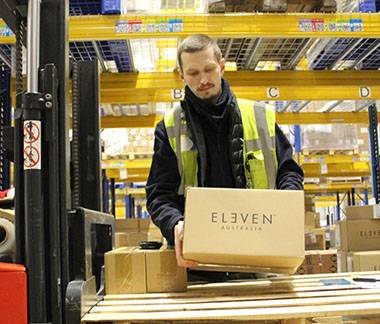What innovations are available for a successful logistics strategy?
Logistics strategy: what innovations are there?
Establishing a logistics strategy is essential to the smooth running of a company. The stakes are high: to increase efficiency and to maintain high productivity. In a context where innovation is the new trend that is revolutionising many sectors of activity, Industry 4.0 has made a striking breakthrough in the logistics organisations and road transport management of every company in France and throughout the world. It incorporates a selection of tools and measures aimed at responding to the environmental emergency and making supply chain management operations more fluid. Greener logistics, but also smarter and more competitive logistics: this is the strategy for increasing the profitability and sales of a company specialising in logistics.
The challenge is significant and the same in the logistics strategies of many companies. In this sense, Wavestone has published an Industry 4.0 barometer indicating that in France, 88% of the companies surveyed in 2021 declared that they had launched Industry 4.0 projects in their logistics strategy.
Discover with Viaposte the best technical innovations and their effect in the development and sustainability of any logistics company.
Logistics strategy: what are the challenges for companies?
Why should your company implement a logistics strategy?
A logistics strategy refers to the internal organisation of a company with the aim of optimising the performance and flow of logistics operations. In order to adopt an effective strategy, various tools, methods or processes can be used and put into practice: in the logistics sector this is known as supply chain management. In order to adapt the processes leading to these objectives, care must be taken to ensure that:
> the customer's expectations concerning the desired services are adhered to;
> there is good management between customers, suppliers and the company;
> there is a smooth running of the logistics service: from storage to distribution of the goods, including their transport;
> safety rules and controls in the storage warehouse are optimised;
> stock management is harmonised.
Logistics strategy and supply chain innovations
Globalisation is at the heart of the logistics development strategy of any company wishing to expand its reputation, but also to increase the sales of its products and services outside France. To take part in this, companies must attach considerable importance to the evolution of the techniques and tools available to them: this is what is known as the logistics of the future. New technologies, automated and robotised logistics management, networked communication relating to the organisation of transport, increased security within the warehouses: the linked circuit of all the goods and products of a company is guaranteed without any glitches, from their departure from the factory to their routing and finally their delivery.
Choosing to mobilise new technologies brings many outcomes to the company:
> increase in the logistical performance of companies;
> improving the working conditions of warehouse staff by delegating the most arduous tasks;
> development of innovative services for customers to facilitate the organisation of digital and physical communication flows;
> reduction of the environmental footprint related to logistics in the design and production of products, as well as their transport.
What are the innovations in logistics?
The logistics sector is far from being spared from digital transformation and technical automation. The ever-changing world of science and the professional training of the most successful researchers in the sector are no strangers to this phenomenon.
Robotisation in the warehouse: towards a systematic automation strategy
Using artificial intelligence to help warehouse management run more smoothly is one of the most important innovations of the last decade. With the automation of certain tasks and processes, the supply chain is optimised and much more operational. By using Automated Guided Vehicles (AGVs), parcel delivery times and costs can be significantly reduced. Robotisation in the warehouse also offers more autonomous management and increases the security of repetitive tasks. Thus, data entry robots, stacker cranes, shuttles or automated cranes in the aisles have joined the teams already in place in the warehouses in order to simplify logistics operations and increase yields. Similarly, the digitisation of data has provided a new way of sharing information between the different parties: software, cloud, internet, Big Data have all contributed to better communication within the company to better plan, forecast and process customer orders.
Clean vehicles and temperature control
Energy innovations are at the heart of environmental concerns. According to a study conducted by Citepa, CO2 emissions from road transport accounted for 94% of total emissions in France in 2019. Reducing greenhouse gas emissions is therefore essential to a company's logistics strategy. Following Viaposte's example, many companies are turning to natural gas or other alternative energies such as biofuel, biogas, hydrogen or even electricity to equip their vehicle fleets. The stakes are twofold: to promote greener transport and to reduce fuel costs. But the innovation does not stop there! The gas engines of refrigerated trucks also power the cold chain. Finally, multiple connected temperature control systems can be placed in the vehicles to ensure that the performance and quality of the products transported remain intact.
Innovation to secure products and goods
Security and safety are an integral part of any good logistics strategy, both during the loading of vehicles and during the delicate stage of transporting goods and making final deliveries to customers. In this sense, solutions for the installation of high-definition surveillance cameras positioned in warehouses or on board trucks are widely appreciated. They make it easy to locate goods and detect any suspicious movement.
This solution can be complemented by TMS (Transport Management System) technology, which enables real-time monitoring of drivers' journeys, including abnormal detection of door openings or possible route diversions, thus avoiding too many disputes between forwarders, drivers and customers.
Viaposte: a company focused on logistics innovations
Like any company, Viaposte has a highly effective logistics strategy. To increase its sorting capacity, it is gradually integrating the most advanced innovations into its processes. In this sense, it has created a surprise by integrating the Sort & Drive sorter model on its platforms or those of its customers, which accelerates the preparation of rounds and has made it possible to keep up with the growth in parcel activity of more than 30% in 2020. With a view to constant development, another sorter, Sort & Move, which is economical, modular and easily transportable, has been developed and installed by Viaposte at its Toulouse, Cavaillon and Saint-Thibault-des-Vignes sites. Viaposte has also developed sorting machines for small, unstable goods at its Velaux, Bordeaux, Chelles, Chilly and Le Bourget platforms.
Finally, as part of our strong environmental commitment, our company is committed to equipping its vehicles or using the vehicles of partner transporters running on the best energies of the future: Compressed Natural Gas (CNG), Liquefied Natural Gas (LNG), Electricity, Biofuel, Hydrogen and Biogas.







